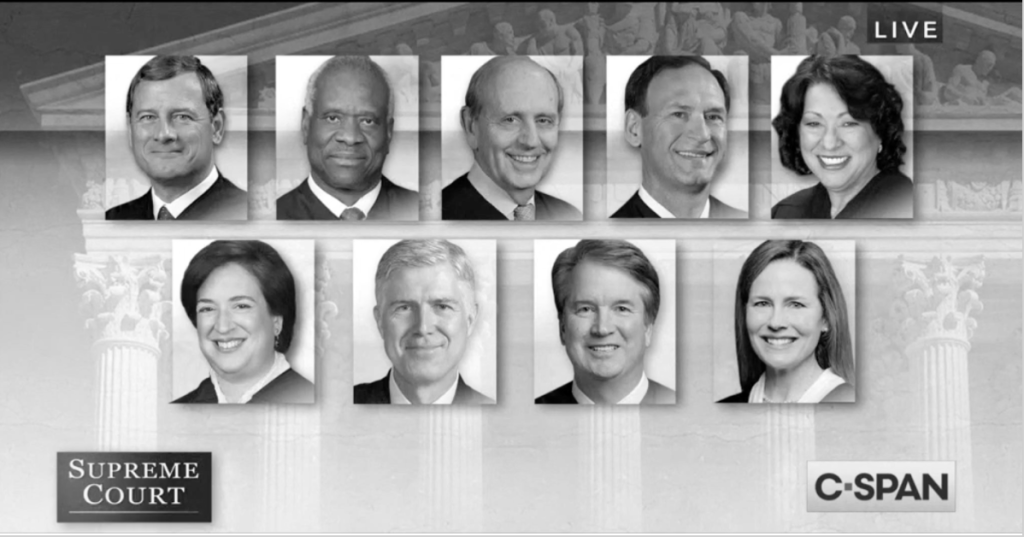The Supreme Court’s Decision on COVID Vaccine Mandates, What it Means for You

The United States Supreme Court on Thursday issued a highly-anticipated decision on two of the Biden Administration’s COVID vaccine mandates.
There is good news and bad news that came out of the Court’s decision. The good news is the Court rejected the Biden administration’s mandate requiring employees of large businesses to be vaccinated against COVID or undergo weekly testing and wear a mask indoors while working.
The court’s conservative majority said the administration overstepped its authority by imposing the Occupational Safety and Health Administration’s (OSHA) vaccine-or-test rule on U.S. businesses with at least 100 employees and prohibited OSHA from enforcing its rules while the consolidated case works its way through the Sixth Circuit.
The bad news is that the court allowed to move forward a separate rule mandating COVID vaccines for workers in healthcare facilities that receive Medicare or Medicaid.
In the OSHA case, the Court concluded OSHA only has authority to regulate “occupational” or workplace dangers. While COVID can certainly be contracted at work, it can also be contracted everywhere else (school, stores, home, etc.). Therefore, COVID is not an “occupational” danger and is outside OSHA’s authority.
The Court said, “Permitting OSHA to regulate the hazards of daily life — simply because most Americans have jobs and face those same risks while on the clock — would significantly expand OSHA’s regulatory authority without clear congressional authorization.”
“This is the correct decision, and it’s great to see that even Chief Justice Roberts saw the light, joining the 5 conservatives for a solid 6-vote majority. Unsurprisingly, Kagan, Sotomayor and Breyer dissented,” said Harry Mihet, vice president of legal affairs and chief litigation counsel at Liberty Counsel.
Although the decision was considered a win for millions of American’s, invalidating OSHA’s mandate only means the federal government cannot force companies to require vaccination or testing. It doesn’t mean “woke” companies cannot implement those requirements on their own, Mihet added.
A majority of the Supreme Court’s justices concluded the applicants challenging OSHA’s mandate were likely to succeed in the merits of their claim and the secretary of labor lacked authority to impose the mandate, resulting in a stay while the case works its way through the 6th Circuit.
In a joint dissent of the OSHA ruling, the court’s three liberal justices argued the court was overreaching by substituting its judgment for that of health experts.
“Acting outside of its competence and without legal basis, the Court displaces the judgments of the Government officials given the responsibility to respond to workplace health emergencies,” Justices Stephen Breyer, Elena Kagan and Sonia Sotomayor wrote in a joint dissent.
The justices contended OSHA’s mandate is comparable to a fire or sanitation regulation imposed by the agency, while the majority said a vaccine mandate is strikingly unlike the workplace regulations that OSHA has typically imposed as a vaccination “cannot be undone at the end of the workday.”
The CMS rule mandating COVID vaccines for healthcare workers
In a separate decision, the court held 5-4 to allow a rule issued by the U.S. Department of Health and Human Services’ Centers for Medicare & Medicaid Services (CMS), to take effect. Justice Roberts, and to the disappointment of many, Justice Brett Kavanaugh joined the liberal justices in their opinion.
The mandate allows the federal government to force hospitals and other healthcare organizations that receive Medicare and Medicaid funding to require COVID vaccinations for their employees.
The rule is estimated to affect 10.3 million healthcare workers in the U.S. but allows for religious and medical exemptions. The rule was previously blocked by two lower courts for the 24 states that challenged the rule.
Essentially, the argument is that if a healthcare organization agrees to take money from the federal government, then the government can prescribe certain standards, including vaccination requirements.
“This is a disappointing and unprecedented opinion, particularly because it pays no attention to the science that says vaccination has no effect on the transmissibility,” said Mihet.
Justice Samuel Alito, joined by conservative Justices Clarence Thomas, Neil Gorsuch and Amy Coney Barrett, dissented.
“Neither CMS nor the Court articulates a limiting principle for why, after an unexplained and unjustified delay, an agency can regulate first and listen later, and then put more than 10 million healthcare workers to the choice of their jobs or an irreversible medical treatment,” Justice Alito wrote.
“The challenges posed by a global pandemic do not allow a federal agency to exercise power that Congress has not conferred upon it. At the same time, such unprecedented circumstances provide no grounds for limiting the exercise of authorities the agency has long been recognized to have,” Justices Alito and Thomas wrote, stating the “latter principle governs” in the healthcare cases.
It should be noted that yesterday’s decision was about whether the federal government could mandate vaccines for healthcare workers who work at facilities that receive Medicare and Medicaid, but it did not do away with the requirement that these facilities provide religious and medical exemptions, as the rule already requires that they do.
The Supreme Court pointed this out at least twice in Thursday’s decision: “The rule requires providers to offer medical and religious exemptions.”
As with OSHA, even if the Court had reached a different conclusion, a hospital still could implement a vaccine requirement on its own, but subject to providing exemptions.
The Supreme Court on Jan. 7 heard oral arguments pertaining to both of the Biden administration’s COVID vaccine mandates. The focus of the hearing was whether to stay or to grant temporary injunctions requested by plaintiffs in a number of lawsuits challenging the emergency mandates for millions of Americans — while the cases play out in the lower courts.